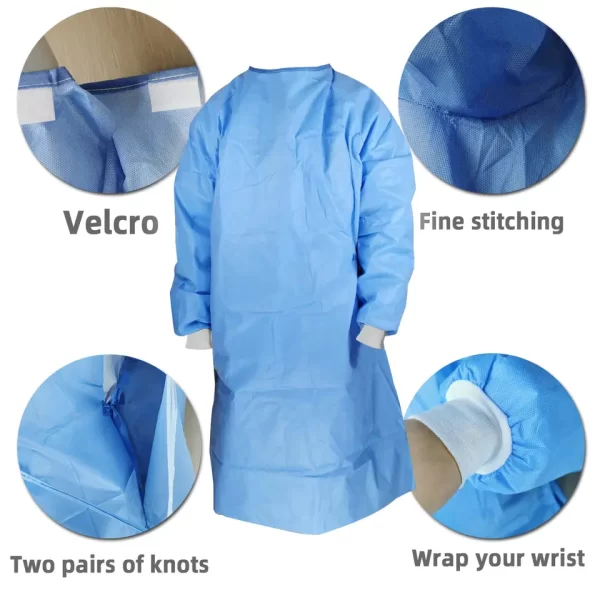Surgical Gowns: Tracing the Evolution of Materials and Design
Part 1: Setting the Scene
The world of surgical gowns is not merely about fabric and design. It is a journey that traces the history of medical science, the evolution of sterility standards, and the relentless quest for patient and healthcare worker safety. This article embarks on this journey, offering a comprehensive examination of the substantial transformations that surgical gowns have undergone, from rudimentary cloth coverings to sophisticated personal protective equipment.
Part 2: The Early Beginnings: Cloth Gowns
Before delving into the evolution of surgical gowns, it’s important to understand the context in which they were conceived. The late 19th century was a period of dramatic change in the medical field, with the germ theory of disease gaining traction. Scientists like Louis Pasteur and Joseph Lister brought to light the significant role of sterility in preventing post-surgical infections.
At the time, surgeons operated in their ordinary clothing, or at most, wore a butcher’s apron to protect their clothes from blood stains. However, the emerging understanding of infection control led to the introduction of simple, washable cloth gowns. Although rudimentary by modern standards, this shift marked the recognition of the operating room as a specialized, sterile environment.
Part 3: Introduction of Sterile Surgical Gowns
With the dawn of the 20th century came significant advancements in medicine and surgery. A heightened awareness of the importance of sterility saw the transition from cloth gowns to sterilized cotton gowns. Autoclaves, machines that sterilize equipment with high-pressure steam, became commonplace in hospitals, and gowns were subjected to this rigorous sterilization process before every surgery.
This era’s gowns were primarily designed for function, offering an added layer of protection against potential infection. Aesthetically, they were simple, often resembling a smock or robe, designed to be easy to wear and remove. These gowns represented a crucial step in surgical safety and the journey towards improved infection control.
Part 4: Arrival of Disposable Surgical Gowns
The mid-20th century was a period of accelerated change, not just in the medical field, but across all industries. The post-World War II era saw the birth of disposable culture, and surgical gowns were no exception.
These disposable surgical gowns, made from synthetic materials like polypropylene, offered a new approach to infection control. Designed for single use, these gowns eliminated the risk of cross-contamination between surgeries. Moreover, disposable gowns were cost-effective and time-saving, eliminating the need for repeated sterilization.
Advancements in material technology led to the development of gowns that provided a high level of protection against fluid and microbial penetration. Thus, the adoption of disposable surgical gowns significantly contributed to reducing surgical site infections’ prevalence.
Part 5: The Modern Era: Advanced Material Technology
As we moved into the late 20th and early 21st centuries, technological advancements paved the way for an era of innovation in the surgical gown industry. Advanced materials like spunlace nonwoven, SMMS (spunbond-meltblown-meltblown-spunbond), and polyethylene films came to the forefront. These materials, with their superior fluid resistance, breathability, and comfort, revolutionized the design and functionality of surgical gowns.
Additionally, this era saw the introduction of reinforced and specialist gowns, allowing for varying levels of protection depending on the procedure. The idea of ‘personalized protection’ came to light, where the choice of gown would be dictated by the risk level of the procedure being conducted. High-risk procedures could now be performed with greater confidence, reducing the fear of pathogen transmission.
Part 6: Design Evolution and Future Trends
While material advancements were taking place, parallel transformations were happening in the design of surgical gowns. Modern surgical gowns evolved to incorporate features such as full frontal coverage, long sleeves, and adjustable necklines. Ergonomics became a crucial consideration, ensuring comfort and flexibility for the wearer without compromising safety.
Moreover, the surgical gown industry has started to acknowledge the environmental impact of disposable gowns. Current trends suggest a movement towards developing eco-friendly, biodegradable surgical gowns. This not only minimizes the ecological footprint of these products but also opens up an exciting avenue for sustainable healthcare practices.
As we look to the future, the potential for innovation seems boundless. With advancements in smart textiles, we may soon witness surgical gowns that can monitor vital signs, detect contamination, or even release antimicrobial agents. This concept of ‘intelligent gowns’ brings a new dimension to patient safety and infection control, underscoring the rapid pace of evolution in this field.
Part 7: Conclusion
Surgical gowns, often viewed as a mundane aspect of medical practice, have been pivotal in enhancing patient safety and infection control in healthcare settings. Their evolution paints a fascinating picture of adaptation, innovation, and relentless improvement. From the humble beginnings of simple cloth gowns to the sophisticated, high-tech gowns of today, each stage of evolution has left an indelible mark on patient care.
As we venture further into the 21st century, the surgical gown industry will continue to innovate, adapt, and evolve to meet the ever-changing needs and challenges of the healthcare landscape. The development of surgical gowns, their materials, and design, therefore, will continue to be a key area of interest for researchers, healthcare professionals, and the industry at large.
Please visit our website for more product details https://medposnonwoven.com/product/surgical-gown-disposable/

